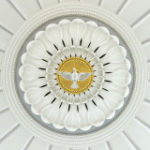On Tuesday of last week I felt very deeply that, as we voted in the Sistine Chapel, we were not just the 115 electors, but a whole world of praying people, also present spiritually and calling down the Holy Spirit upon us. Numerous letters, e-mails and telephone messages confirmed this, and they came not only from our Catholic people, but from members of other Christian Churches and from Jewish and Muslim friends.
What happened in Rome when the white smoke rose gave proof of what Pope Benedict XVI said at his Mass at the beginning of his pastoral service last Sunday, “The Church is alive, and the Church is young.” The media are not able to register the presence and the action of the Holy Spirit. But the media do show what happens when the Spirit is at work.
I would like to acknowledge the wonderful efforts of the media in this past month, making it possible for so many to participate in our farewell to beloved Pope John Paul II and the welcome of our Catholic world, and indeed, of people of good will everywhere, to Pope Benedict XVI. The media relayed the images of the vast crowds gathered as Pope John Paul lay dying and then at his funeral. We remember him as a beloved Holy Father who visited this Cathedral ten years ago and placed in my hands the chalice in use at this Mass.
There were vast crowds also, and they gathered quickly, when Pope Benedict XVI was elected. When we cardinals entered the Sistine Chapel, we did not know how long it would take us to find a successor for the Apostle Peter. We were reminded that our effort was like that of the Magi from the East, who followed a star, who knew that a special person had been born but did not know who this person was. But God knew, and God’s Spirit guided us.
The deacon Philip, as reported in the First Reading, created quite a stir in Samaria when the people “saw the signs he was doing.” During the conclave, we cardinals could renew our acquaintance among ourselves, and hear about the work of the Church in various parts of the world. What I heard is illustrated in the first reading: in the mission countries especially, the Holy Spirit is using the Church to accomplish what Jesus and the deacon Philip did in the early days of the Christian Faith: they were casting out unclean spirits and curing “many paralyzed or crippled people.” Next came a sacramental step: Peter and John were sent to confirm those who had been baptized but not confirmed. The sacrament completed their preparation for receiving the Lord Jesus himself in the Eucharist.
Our actual conclave was a kind of spiritual retreat. The setting was an awesome one, the Sistine Chapel, with the greatest religious art in the world. I found very helpful the marvelous fresco of Perugino, depicting the Lord Jesus giving the keys of the heavenly kingdom to the Apostle Peter. But also, directly overhead were the incredible scenes from the Book of Genesis recounting, with incredible power, the story of the Creation and Fall of our first parents, the initial alienation that Jesus came to heal. And, to my left, was the masterpiece of Michelangelo, the Last Judgment, before which each of us Cardinals, mindful of Jesus who would judge us, swore that we would cast our ballots for the one we thought most worthy to guide the Church in the coming years.
In his last published poem, Roman Triptych, Pope John Paul described the scene:
“Those entrusted with the legacy of the keys
gather here, letting themselves be enfolded by the Sistine’s colors,
by the vision left to us be Michelangelo–….
So it will be once more, when the time comes, after my death.
Michelangelo’s vision must then speak to them.
“Con-clave”: a shared concern for the legacy of the keys, the keys of the Kingdom.
Lo, they see themselves in the midst of the Beginning and the End,
between the Day of Creation and the Day of Judgment…
It is granted man once to die, and the

